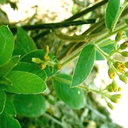Identification of anti-inflammatory constituents from Kalimeris indica with UHPLC-ESI-Q-TOF-MS/MS and GC-MS.
Nyckelord
Abstrakt
BACKGROUND
Kalimeris indica is a Miao׳s medicinal plant in Guizhou province of China employing to treat various inflammation-related diseases in clinical. The study aims to determine the active fractions of K. indica for its anti-inflammatory activity and to identify their chemical constituents.
METHODS
The dried K. indica herb was extracted with 50% aqueous ethanol and then successively separated with macroporous resin and MCI column chromatography to give five fractions (A-E). The anti-inflammatory effects were determined by measuring the NO and TNF-α production in murine macrophage RAW 264.7 cells after exposure to LPS. The chemical constituents of the anti-inflammatory fractions were analyzed by the method of UHPLC-ESI-Q-TOF/MS or GC-MS.
RESULTS
Five fractions (A-E) of different polarities were prepared from the 50% ethanol extract. Factions C and E showed significant inhibition of NO and TNF-α production. Six constituents, namely 3,4-dicaffeoylquinic acid (1), 3,5-dicaffeoylquinic acid (2), 1,5-dicaffeoylquinic acid (3), rutin (4), 1-malonyl-3,5-dicaffeoylquinic acid (5), and 4,5-dicaffeoylquinic acid (6) were identified from the active fraction C by UHPLC-ESI-Q-TOF/MS. Four compounds including 13-tetradecenal (7), (Z,Z)-9,12-octadecadienoic acid (8), (3α)-12-oleanen-3-yl acetate (9), and (+)-3-oxo-urs-12-en-24-oic acid methyl ester (10) were identified from the active fraction E by GC-MS.
CONCLUSIONS
K. indica possessed pronounced anti-inflammatory effect. Dicaffeoylquinic acids and their dirivatives, rutin, as well as oleanolic and fatty acid derivatives are the major constituents and possibly the anti-inflammatory principles of the active fractions of K. indica. All the compounds were identified in K. indica for the first time. The work provided evidence for further development and utilization of K. indica and formed a basis for the establishment of quality control methods and standards for K. indica and its pharmaceutical preparations.





